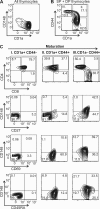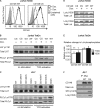Regulation of Src family kinases involved in T cell receptor signaling by protein-tyrosine phosphatase CD148
- PMID: 21543337
- PMCID: PMC3121354
- DOI: 10.1074/jbc.M110.196733
Regulation of Src family kinases involved in T cell receptor signaling by protein-tyrosine phosphatase CD148
Abstract
CD148 is a receptor-like protein-tyrosine phosphatase known to inhibit transduction of mitogenic signals in non-hematopoietic cells. Similarly, in the hematopoietic lineage, CD148 inhibited signal transduction downstream of T cell receptor. However, it also augmented immunoreceptor signaling in B cells and macrophages via dephosphorylating C-terminal tyrosine of Src family kinases (SFK). Accordingly, endogenous CD148 compensated for the loss of the main SFK activator CD45 in murine B cells and macrophages but not in T cells. Hypothetical explanations for the difference between T cells and other leukocyte lineages include the inability of CD148 to dephosphorylate a specific set of SFKs involved in T cell activation or the lack of CD148 expression during critical stages of T cell development. Here we describe striking differences in CD148 expression between human and murine thymocyte subsets, the only unifying feature being the absence of CD148 during the positive selection when the major developmental block occurs under CD45 deficiency. Moreover, we demonstrate that similar to CD45, CD148 has both activating and inhibitory effects on the SFKs involved in TCR signaling. However, in the absence of CD45, activating effects prevail, resulting in functional complementation of CD45 deficiency in human T cell lines. Importantly, this is independent of the tyrosines in the CD148 C-terminal tail, contradicting the recently proposed phosphotyrosine displacement model as a mechanism of SFK activation by CD148. Collectively, our data suggest that differential effects of CD148 in T cells and other leukocyte subsets cannot be explained by the CD148 inability to activate T cell SFKs but rather by its dual inhibitory/activatory function and specific expression pattern.
Figures








Similar articles
-
Structurally distinct phosphatases CD45 and CD148 both regulate B cell and macrophage immunoreceptor signaling.Immunity. 2008 Feb;28(2):183-96. doi: 10.1016/j.immuni.2007.11.024. Epub 2008 Jan 31. Immunity. 2008. PMID: 18249142 Free PMC article.
-
CD148 enhances platelet responsiveness to collagen by maintaining a pool of active Src family kinases.J Thromb Haemost. 2010 Jul;8(7):1575-83. doi: 10.1111/j.1538-7836.2010.03865.x. Epub 2010 Mar 23. J Thromb Haemost. 2010. PMID: 20345711
-
The large ectodomains of CD45 and CD148 regulate their segregation from and inhibition of ligated T-cell receptor.Blood. 2013 May 23;121(21):4295-302. doi: 10.1182/blood-2012-07-442251. Epub 2013 Apr 11. Blood. 2013. PMID: 23580664 Free PMC article.
-
CD45, CD148, and Lyp/Pep: critical phosphatases regulating Src family kinase signaling networks in immune cells.Immunol Rev. 2009 Mar;228(1):288-311. doi: 10.1111/j.1600-065X.2008.00752.x. Immunol Rev. 2009. PMID: 19290935 Free PMC article. Review.
-
The leukocyte common antigen, CD45 and other protein tyrosine phosphatases in hematopoietic cells.Semin Cell Biol. 1993 Dec;4(6):409-18. doi: 10.1006/scel.1993.1049. Semin Cell Biol. 1993. PMID: 8305680 Review.
Cited by
-
Phosphatase regulation of immunoreceptor signaling in T cells, B cells and mast cells.Curr Opin Immunol. 2013 Jun;25(3):313-20. doi: 10.1016/j.coi.2013.04.001. Epub 2013 May 15. Curr Opin Immunol. 2013. PMID: 23684445 Free PMC article. Review.
-
A high-resolution mass spectrometry based proteomic dataset of human regulatory T cells.Data Brief. 2021 Dec 6;40:107687. doi: 10.1016/j.dib.2021.107687. eCollection 2022 Feb. Data Brief. 2021. PMID: 34950757 Free PMC article.
-
Regulation of CD4+ T Cell Signaling and Immunological Synapse by Protein Tyrosine Phosphatases: Molecular Mechanisms in Autoimmunity.Front Immunol. 2019 Jun 26;10:1447. doi: 10.3389/fimmu.2019.01447. eCollection 2019. Front Immunol. 2019. PMID: 31297117 Free PMC article. Review.
-
Expression and function of the protein tyrosine phosphatase receptor J (PTPRJ) in normal mammary epithelial cells and breast tumors.PLoS One. 2012;7(7):e40742. doi: 10.1371/journal.pone.0040742. Epub 2012 Jul 17. PLoS One. 2012. PMID: 22815804 Free PMC article.
-
Regulated expression of PTPRJ/CD148 and an antisense long noncoding RNA in macrophages by proinflammatory stimuli.PLoS One. 2013 Jun 28;8(6):e68306. doi: 10.1371/journal.pone.0068306. Print 2013. PLoS One. 2013. PMID: 23840844 Free PMC article.
References
-
- Honda H., Inazawa J., Nishida J., Yazaki Y., Hirai H. (1994) Blood 84, 4186–4194 - PubMed
-
- Kuramochi S., Matsuda S., Matsuda Y., Saitoh T., Ohsugi M., Yamamoto T. (1996) FEBS Lett. 378, 7–14 - PubMed
-
- Zhang L., Martelli M. L., Battaglia C., Trapasso F., Tramontano D., Viglietto G., Porcellini A., Santoro M., Fusco A. (1997) Exp. Cell Res. 235, 62–70 - PubMed
-
- Autschbach F., Palou E., Mechtersheimer G., Rohr C., Pirotto F., Gassler N., Otto H. F., Schraven B., Gaya A. (1999) Tissue Antigens 54, 485–498 - PubMed
Publication types
MeSH terms
Substances
Grants and funding
LinkOut - more resources
Full Text Sources
Molecular Biology Databases
Research Materials
Miscellaneous

